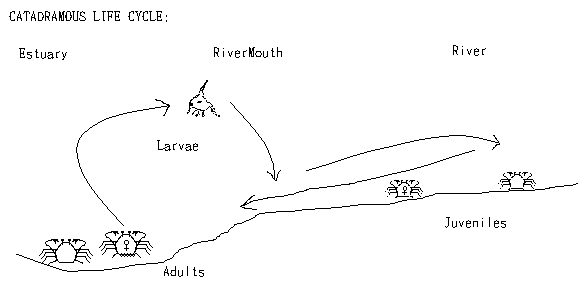

catadromous: a species which spawns in saltwater, then migrates into freshwater where it grows to maturity, ex: Chinese mitten crab, Atlantic eel. (Sumich, J. L. 1988. An Introduction to the Biology of Marine Life. 4th ed. Wm. C. Brown Publishers. Dubuque, Iowa.)
The Chinese mitten crab spends most of its life (2-3 years) in freshwater, feeding and living in burrows excavated in the riverbanks. When the crabs reach maturity they migrate downstream into the estuary where they mate. Female mitten crabs carry their eggs (up to one million) on the underside of their abdomen. Larvae hatch and molt through 5 stages in progressively less salty water. Larval stages last 5-6 months , after their final larval molt the juvenile crabs settle and begin migrating upstream. Migrating crabs have been known to walk over and/or around obstacles such as dams. Crabs may also cross over land into other watersheds during their migration (they have can survive up to 32 days without emersion although they require some re-wetting in rain, ponds, puddles etc. Males are believed to migrate further upstream than females. (Panning, 1938)
created 5/4/98